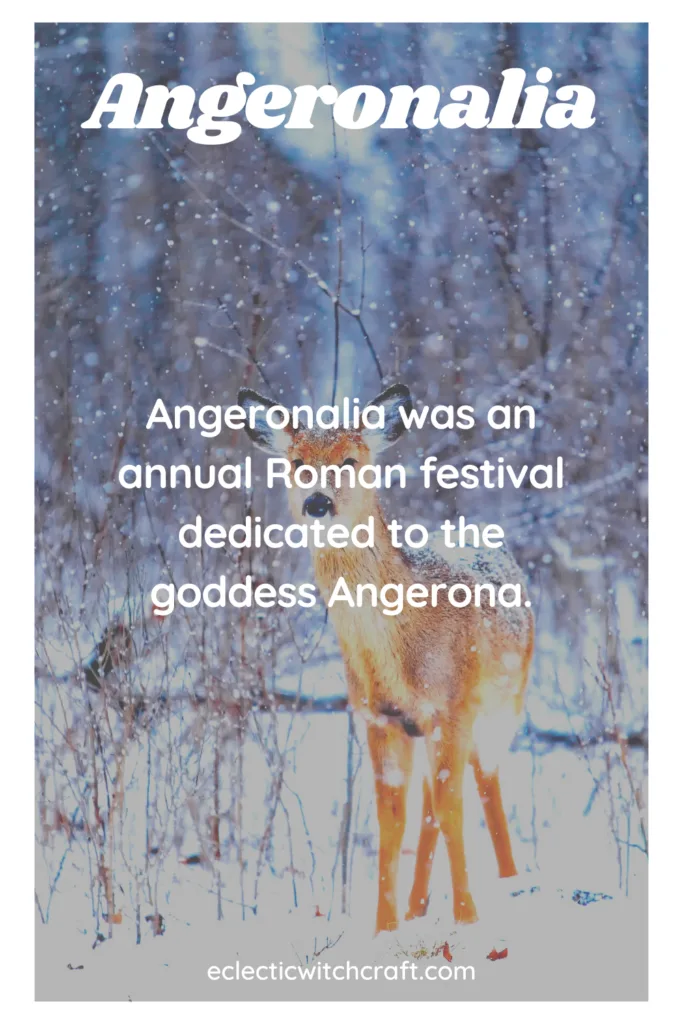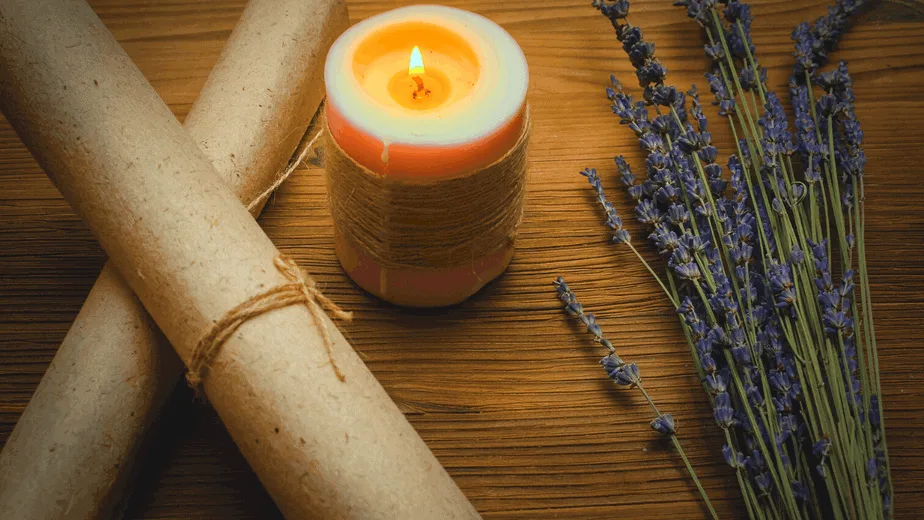Please note that posts on this site may contain affiliate links
Angeronalia (or Divalia) is an ancient Roman festival celebrated annually on 21 December. It was dedicated to the goddess Angerona, who was thought to protect Rome from danger and keep its secrets safe. This festival was also a time for purification of the city, as well as making offerings in gratitude for past protection and blessings from the gods.
The celebration of Angeronalia involved a number of rituals. People would make offerings to the gods, such as incense and food, while prayers were offered for protection from harm. They also lit candles around their homes and took part in special ceremonies at temples throughout Rome. In addition, people would gather for a feast to celebrate their continued safety and prosperity.
Angeronalia is an important part of Roman history, giving us insight into the importance placed on religion by the Romans during this period. Even today, it serves as a reminder that even in times of difficulty or danger, there are still reasons to be thankful and celebrate life’s successes – even if they seem small compared to what we might have been hoping for. From lighting candles around our homes to taking part in traditional practices at temples, celebrating Angeronalia can help us stay grounded when things are tough and remind us that we have much to be grateful for despite our current circumstances!
Who was Angerona and what were her functions as a goddess?
Angerona was an ancient Roman goddess known for her ability to protect, heal, and aid those in need. She was the guardian of secrets, as well as the one who gave her followers the strength and courage to overcome the difficulty of the long winter months.
Angerona had a special significance to Ancient Romans because she served as a symbol of hope during times of hardship. Her healing powers were said to cure illnesses, alleviate pain, and even bring forth prosperity. It is no wonder that she was honored with the annual festival of Angeronalia – a time to offer thanks for all that she provided.
By celebrating this goddess’s many gifts, Ancient Romans could find solace in her divine protection and guidance during difficult times. So even today, we can still look to Angerona as an example of strength and resilience in the face of adversity.

Origins and History of the Festival
The festival of Angeronalia had its roots in ancient Roman beliefs and traditions. The festival was celebrated during the winter solstice, which was an important time of year for the Romans. They believed that during the winter solstice, the sun was being reborn, and that it was a time of new beginnings.
During Angeronalia, people gathered together to offer prayers, gifts, and sacrifices to show their appreciation for the goddess. They believed that by honoring her in this way they would receive blessings of protection and healing. The festival was also a time of celebration; it offered an opportunity for people to come together in joyous tribute to Angerona’s gifts.
Ancient Roman Celebrations in Honor of Angerona
During the festival of Angeronalia, the priests would offer sacrifices to Angerona in the temple of Volupia, the goddess of pleasure. The statue of Angerona in the temple was depicted with a finger on her mouth, which was bound and closed. This symbolized the importance of secrecy during the festival. The festival was also a time of feasting and merriment, with processions and parades taking place throughout the city.
This ancient tradition stands today as a reminder of the strength found in times of hardship. It encourages us to look within ourselves for courage and hope, no matter how dark things may seem at first. We owe it all to the powerful goddess Angerona who has been blessing us with her divine protection since antiquity.

Celebrations of the Festival
The celebrations of Angeronalia were a time of ritual and reverence. During this festival, people would gather in the temple of Volupia, offering prayers and gifts as tribute to Angerona. The statue of the goddess was depicted with her finger on her mouth, symbolizing the importance of secrecy to this many-talented goddess.
Besides prayer and offerings, people also took part in processions and parades throughout the city. Music and dancing accompanied these processions, allowing participants to share their joy and gratitude for all that the goddess had done for them.
At nightfall, candles were lit around homes to call upon Angerona’s divine protection. This was a symbolic gesture that showed people’s appreciation for her strength and guidance during dark times. Feasting was also an important part of the celebrations, with tables laid out with delicacies from near and far. People would break bread together in joyous tribute to the goddess who had provided so much for them during difficult times.
Significance of Angeronalia Today
The festival of Angeronalia is an ancient Roman tradition that still holds great significance today. It is a time to honor the gods and goddesses, particularly Angerona, the goddess of secrets and strength, who provided protection during difficult times.
Today, we can still look to Angerona as an example of resilience in times of hardship. Her many gifts remind us of the importance of strength and courage even when things seem dark at first. By reflecting on this ancient tradition, we can find solace in knowing that no matter what comes our way, there are always new beginnings just around the corner.
Relevance to Modern Society
The ancient festival of Angeronalia is a celebration that has been held for centuries and is still celebrated by modern pagans and witches. This pagan holiday occurs on the Winter Solstice, when it was believed that the sun was slowly returning to full strength and, thus, restored life to the resting Earth following its descent into darkness.
The festival is celebrated as a time to honor Angerona and the rebirth of the sun, as well as to recognize the ever-changing nature of life and seasonal cycles. It’s a time for divination, contemplation, and spiritual growth as people come together to recognize the turning of seasons and their own pivotal roles in guiding their lives within them.
During Angeronalia, many different types of rituals may be conducted; some believe in performing fasting or making sacrifices in order to gain personal insight or transformation during this sacred time period. Others celebrate this holiday by gathering with loved ones to share expressions of love and renewal for the shifting year ahead.
Either way, modern pagans and witches use this holiday season as an opportunity to look within themselves for new sources of strength, clarity, determination, and gratitude – all powerful tools that can help one live more effectively throughout the year ahead.

Continuing Traditions in Honor of Angeronalia
Modern pagans and witches who wish to continue the traditions of Angeronalia can do so in a variety of ways. One way is to light candles or have bonfires at the winter solstice as a way to mark the occasion. This serves both as a physical reminder of the importance of honoring our beliefs and traditions, but also as a way to be with friends and family to share in this special time together.
Another way to honor Angeronalia is with a feast. Traditional meals may include roasted meats, fruits, nuts, and spices like cinnamon and nutmeg that were used in celebration during ancient Rome. Eating these foods can help bring those old traditions into modern times while allowing us to come together over a shared meal.
Finally, rituals are an important part of many pagan and witch practices, including Angeronalia. People might take this opportunity to perform rituals that focus on connecting with ancestors or gods – or simply thanking them for their presence in our lives. meditations focusing on self-love and gratitude are also meaningful activities that can be done to celebrate Angeronalia, no matter how busy one’s life may be.
By continuing these traditional celebrations for modern pagans and witches, we ensure that the importance of honoring our beliefs remains alive for future generations by passing down stories and lessons of what has come before us.
| Symbol/Activity | Meaning/Explanation |
|---|---|
| Offerings to the gods | A gesture of gratitude and appreciation for past protection and blessings from the gods |
| Lighting of candles | A symbolic gesture of calling upon Angerona’s divine protection during dark times |
| Feasting | A time to celebrate and come together in joyous tribute to the goddess who provided so much for them during difficult times |
| Prayer | An expression of reverence and a way to connect with the divine |
| Processions and Parades | A way to honor Angerona and the rebirth of the sun, as well as to recognize the ever-changing nature of life and seasonal cycles |
| Rituals | A way to connect with ancestors or gods, thank them for their presence in our lives, and gain personal insight or transformation |
Conclusion
Angeronalia is a timeless tradition that has been passed down through generations. It serves as a reminder of our shared faith and provides us with an opportunity to come together as one. Celebrating Angeronalia allows us to strengthen our relationships and gain courage in the face of adversity. We must never forget its importance, nor be denied its powerful protection. Let us honor the goddess Angerona by continuing the traditions of this sacred celebration and unifying ourselves in solidarity.

